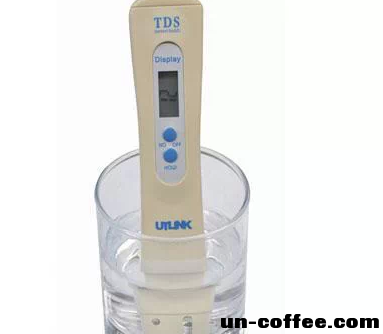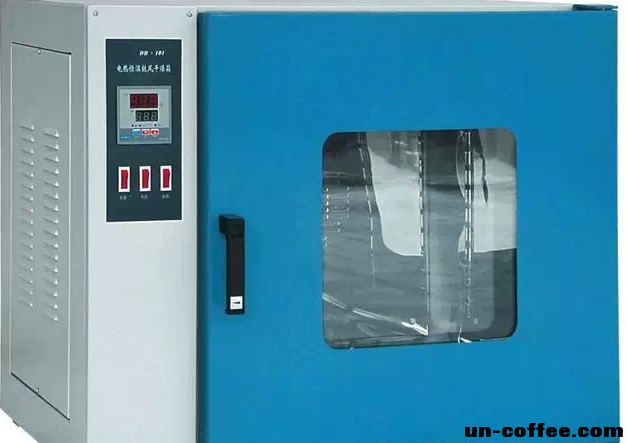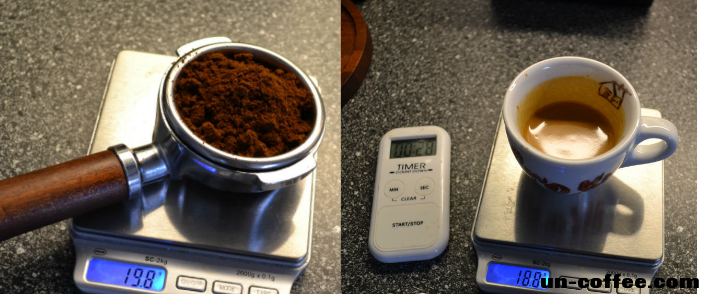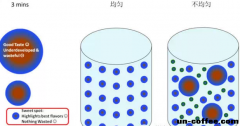The coffee extraction, the coffee extraction.
I. interpretation of extraction-related terms
30% of the ingredients in coffee beans are soluble, and these 30% contain organic substances that provide aroma and taste. These organic substances contain all the good and bad properties, so it is not that the higher the extraction rate, the better the taste and aroma. In addition, a moderate concentration is an important factor that can not be ignored for the overall taste.
(1) the method of concentration determination:
1. The refractometer (vst meter) measures the change of the refraction angle of the air in the liquid and converts it to get the tds reading in'%'.
Usage: 0.1% for water, 1.3% for coffee, 1.2% for tds (relatively convenient)
2. Conductive pen (tds pen) the measurement of the electrical conductivity of the electrolyte in the soluble matter in the liquid shows that the bound electrolyte accounts for about 10% of the total soluble matter, and the tds reading in units of 'ppm' is converted.
Usage: 100ppm for water, 1300ppm for coffee, and tds 12000ppm for coffee, 1.2% (relatively cumbersome)

3. Evaporation drying: after the coffee liquid is dried, the weight of the soluble matter can be obtained. Combined with the total weight of the liquid, the concentration can be obtained (relatively accurate).

Note: with regard to the concentration recommendation, that is, the concentration recommendation of Gold Cup, SCAA recommends 1.15% SCAA and SCAE 1.45%.
(2) conversion of extraction rate:
1. Refractometer or conductive pen reading * Coffee liquid total weight / solid weight
2. The weight of dissolved matter / solid weight obtained after drying the coffee liquid.
Remarks: 1. Ppm is the abbreviation of parts per million, translated as part of per million, that is, parts per million (parts per million), or parts per million. 1ppm, for example, contains 1kg of solute in a solution of one million kilograms. Ppm is the same as the percentage (%), except that the percentage is larger than the percentage.
2. Among the three methods, the natural drying method is the most accurate, but the drying method requires high experimental environment; the other two conversion methods, because of the uncontrollable variables caused by different production methods, actually ignore the factor of coffee water absorption.
(3) the method of calculating the extraction rate by combining the specific coffee utensils.
For the convenience of calculation, it is assumed that the TDS of water is 0, of course, it is usually necessary to subtract the value of TDS of water.
1. Immersion type (French kettle, smart cup, Cupping, etc.)

Amount of water used * TSD (concentration) / coffee powder
For example: 240g (water) * 1.2% Universe 15g 19.2%
2, follicular type (such as hand flushing, CHEMEX, Philharmonic pressure, flannel, etc.)

Weight of coffee liquid * TSD (concentration) / amount of coffee powder (e.g.: 240g (coffee liquid) * 1.2% 15g coffee 19.2%)
Or (amount of water used-coffee powder absorbs water) * TSD (concentration) / coffee powder quantity
Note: coffee powder absorbs water, and the theoretical value is twice the weight of coffee powder.
For example, [280g (water)-30g (coffee powder absorbs water)] * 1.2% Coffee 15g 20%
3. Espresso
Before testing TDS, espresso needs to filter the suspended particles insoluble in water in the liquid. (if there is no special filter equipped with VST concentration meter, filter paper can be used instead)

Weight of coffee liquid * TSD (concentration) / amount of coffee powder (e. G.: 36g / 10g / 18g / 20g)
Important Notice :
前街咖啡 FrontStreet Coffee has moved to new addredd:
FrontStreet Coffee Address: 315,Donghua East Road,GuangZhou
Tel:020 38364473
- Prev

Eight effects of caffeine on people's mind and body
Drinking coffee is addictive, or it's a habit you can't get rid of, and sometimes drinking too much coffee will have a certain impact on your mood, which may make your nerves very nervous and restless. But the role of coffee on the human body can not be ignored, whether in mental or physical function, caffeine can play a good role. Next, let's take a look at
- Next

Those things about coffee extraction extraction and extraction equilibrium
2. Extraction and extraction equilibrium s the reasonable extraction range is set by ebf, and the extraction results are tested by tds. Combined with the grinding scale and the ratio of gouache to powder to modify the results, it is the quality control system of most knowledge-based barista when making espresso. Under this seemingly rigorous operation process, will there be loopholes? Extraction uniformity is a monitoring blind area which is easy to be ignored.
Related
- Detailed explanation of Jadeite planting Land in Panamanian Jadeite Manor introduction to the grading system of Jadeite competitive bidding, Red bid, Green bid and Rose Summer
- Story of Coffee planting in Brenka region of Costa Rica Stonehenge Manor anaerobic heavy honey treatment of flavor mouth
- What's on the barrel of Blue Mountain Coffee beans?
- Can American coffee also pull flowers? How to use hot American style to pull out a good-looking pattern?
- Can you make a cold extract with coffee beans? What is the right proportion for cold-extracted coffee formula?
- Indonesian PWN Gold Mandrine Coffee Origin Features Flavor How to Chong? Mandolin coffee is American.
- A brief introduction to the flavor characteristics of Brazilian yellow bourbon coffee beans
- What is the effect of different water quality on the flavor of cold-extracted coffee? What kind of water is best for brewing coffee?
- Why do you think of Rose Summer whenever you mention Panamanian coffee?
- Introduction to the characteristics of authentic blue mountain coffee bean producing areas? What is the CIB Coffee Authority in Jamaica?

